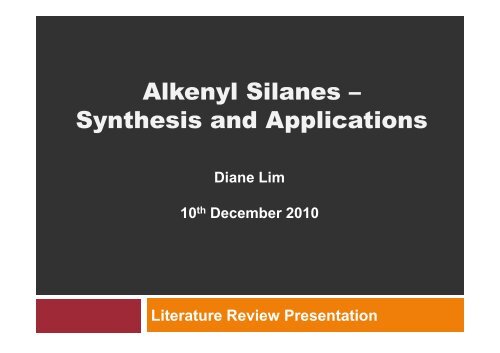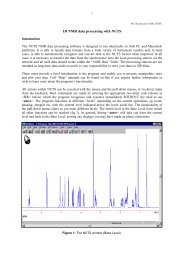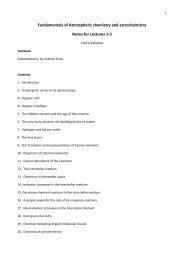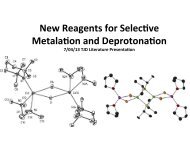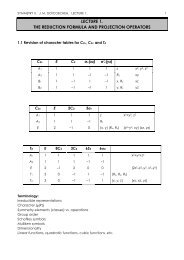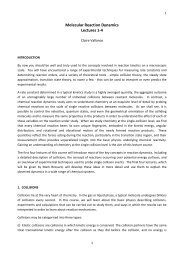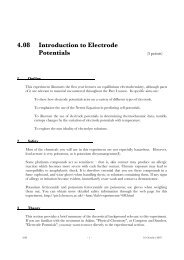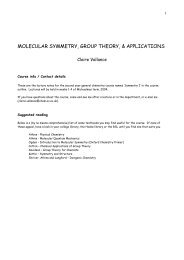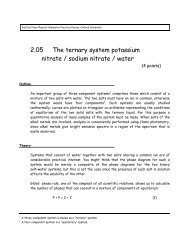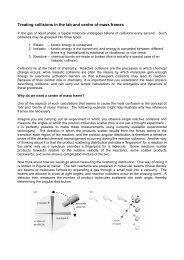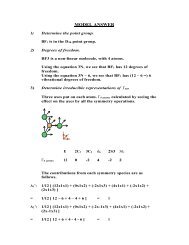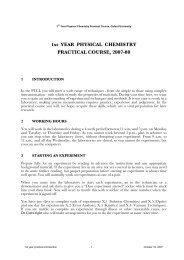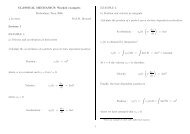Synthesis and Applications - The Anderson Research Group
Synthesis and Applications - The Anderson Research Group
Synthesis and Applications - The Anderson Research Group
Create successful ePaper yourself
Turn your PDF publications into a flip-book with our unique Google optimized e-Paper software.
Alkenyl Silanes –<br />
<strong>Synthesis</strong> <strong>and</strong> <strong>Applications</strong><br />
Diane Lim<br />
10 th December 2010<br />
Literature Review Presentation
Overview<br />
Introduction<br />
<strong>Synthesis</strong> of Alkenyl Silanes<br />
Alkynes<br />
Silyl Alkynes<br />
Terminal Vinyl Silanes<br />
Aldehydes<br />
<strong>Applications</strong> of Alkenyl Silanes<br />
Carbon-Oxygen Bond Formations<br />
Carbon-Carbon Bond Formations
Introduction SiR' 3<br />
R<br />
Advantages of Alkenyl Silanes<br />
• behaves as latent functional groups unmasked through oxidation<br />
• activated under mild fluoride conditions<br />
• sufficiently stable to acid/base conditions <strong>and</strong> silica gel to carry through synthesis<br />
• relatively cheap <strong>and</strong> wide range of silyl precursors commercially available<br />
• organosilanes <strong>and</strong> reaction by-products are relatively non-toxic<br />
Disadvantages of Alkenyl Silanes<br />
Si-C bond lacks significant dipole <strong>and</strong> requires activation either by a heteroatom substituent<br />
or a fluoride source<br />
Types of Alkenyl Silane Substitution<br />
• all alkyl – TMS, TES, TBDMS etc.<br />
• oxygen – SiR n (OR) 3-n , SiMe 2 (OH), cyclic siloxanes<br />
• hydrogen<br />
• halides – fluoro, chloro<br />
• ‘safety-catch silanols’ – reveals silanol under fluoride or basic conditions<br />
Siletanes; Triallylsilanes; Dimethylbenzyl, phenyl, 2-pyridyl, 2-thienylsilanes
<strong>Synthesis</strong> of Alkenyl Silanes<br />
Alkynes<br />
Hydrosilylation<br />
Silylformylation<br />
(Carbonylative) Silylcarbocyclisation<br />
Silyl Alkynes<br />
Terminal Vinyl Silanes<br />
Aldehydes
Alkynes - Hydrosilylation<br />
Terminal Alkynes<br />
Platinum-based catalysts (Speier’s, H 2 (PtCl 6 ).6H 2 O <strong>and</strong> Karstedt’s) effect synhydrosilylation<br />
of terminal alkynes to provide trans-vinyl silanes exclusively.<br />
β-trans vinyl silanes<br />
β-trans β-cis α<br />
López <strong>and</strong> co-workers have demonstrated the tolerance of Karstedt’s catalyst<br />
to a wide variety of Si substituents in the synthesis of silyl dienes.<br />
• Improved<br />
reactivity <strong>and</strong><br />
regioselectivity<br />
compared to<br />
H 2 (PtCl 6 ).xH 2 O<br />
• < 1 mol% loading<br />
For the synthesis of Karstedt’s catalyst: Ch<strong>and</strong>ra, G.; Lo, P.Y.; Hitchcock, P.B.; Lappert, M.F. Organomet. 1987, 6, 191-192.<br />
Montenegro, J.; Bergueiro, J.; Saá, C.; López, S. Org. Lett. 2009, 11, 141-144.
Alkynes - Hydrosilylation<br />
Terminal Alkynes<br />
β-cis vinyl silanes<br />
β-trans β-cis α<br />
Cl<br />
Cl Ru<br />
Ru Cl<br />
Cl<br />
Ruthenium-based catalysts mediate the anti-hydrosilylation of terminal alkynes.<br />
Regio- <strong>and</strong> stereoselectivities are influenced by Si substituents <strong>and</strong> the proximity<br />
of free hydroxyl groups.<br />
[RuCl 2 (p-cymene)] 2<br />
aka magic dust<br />
[RuCl 2 (p-cymene)] 2 catalyst: Chang, S.; Na, Y. Org. Lett. 2000, 2, 1887-1889.<br />
Grubbs 1 st generation catalyst: Maifield, S.V.; Tran, M.N.; Lee, D. Tetrahedron Lett. 2005, 46, 105-108.
Alkynes - Hydrosilylation<br />
Terminal Alkynes<br />
α vinyl silanes<br />
β-cis β-trans α<br />
<strong>The</strong> cyclopentadienylruthenium complex developed by Trost et al. provides<br />
1,1-disubstituted vinyl silanes.<br />
<strong>The</strong> reaction proceeds smoothly in the presence of halides, alkenes, esters,<br />
protected amines <strong>and</strong> free alcohols <strong>and</strong> carboxylic acids.<br />
TBSO<br />
PMBO<br />
Terminal alkynes are significantly more reactive than internal alkynes.<br />
OTBS<br />
no reaction<br />
Trost, B.M.; Ball, Z.T. J. Am. Chem. Soc. 2005, 127, 17644-17655.
Alkynes - Hydrosilylation<br />
Internal Alkynes<br />
Trost’s catalyst also affords tri-substituted silyl alkenes from internal alkynes via anti addition.<br />
<strong>The</strong> silyl group preferentially occupies the distal position to small alkyl groups, (homo)propargylic<br />
alcohols <strong>and</strong> carbonyls.<br />
When the silane hydride is tethered to the alkyne via O-silylation, 6- <strong>and</strong> 7-membered endocyclic vinyl<br />
siloxanes are formed exclusively. A one-pot two-step procedure of O-silylation followed by<br />
hydrosilylation has been developed using TMDS.<br />
<strong>The</strong> total synthesis of (+)-spectaline has been accomplished in 3 steps from the hydroxy alkyne.<br />
Linear alkynes : Trost, B.M.; Ball, Z.T. J. Am. Chem. Soc. 2005, 127, 17644-17655.<br />
Cyclic silanes: Trost, B.M.; Ball, Z.T. J. Am. Chem. Soc. 2003, 125, 30-31;(+)-spectaline: J. Am. Chem. Soc. 2005, 127, 10028-10038.
Alkynes - Hydrosilylation<br />
Internal Alkynes<br />
Exocyclic 5-membered siloxanes can be prepared stereoselectively from homopropargylic alcohols<br />
utilising a similar O-silylation <strong>and</strong> hydrosilylation sequence.<br />
Speier’s catalyst yields the E- <strong>and</strong> terminal alkenes while aryl [Ru] catalysts afford the Z- product.<br />
E-Vinyl Silanes<br />
Terminal alkenes<br />
Z-Vinyl Silanes<br />
Propargylic alcohols do not cyclise in this manner. Under similar conditions, polymerisation occurs<br />
instead.<br />
A two-atom disiloxane tether, installed with tetramethyldisiloxane <strong>and</strong> Stryker’s catalyst [HCu(PPh 3 )] 6 ,<br />
allows cyclisation of propargylic alcohols.<br />
E- <strong>and</strong> terminal vinyl silanes: Marshall, J.A.; Yanik, M.M. Org. Lett. 2000, 2, 2173-2175.<br />
Z-Vinyl silanes: Denmark, S.E.; Pan, W. Org. Lett. 2002, 4, 4163-4166 Propargylic alcohols: Denmark, S.E.; Pan, W. Org. Lett. 2003, 5, 1119-1122.
Alkynes - Silylformylation<br />
Terminal <strong>and</strong> Internal Alkynes<br />
Silylformylation of tethered dimethylsilyl ether-alkynes by Rh <strong>and</strong> Rh-Co complexes proceeds with<br />
opposite regioselectivity to the intermolecular reaction, forming exo-oxasilacycles exclusively.<br />
Internal alkynes <strong>and</strong> cyclic systems are tolerated, affording tetrasubstituted <strong>and</strong> bicyclic vinyl silanes<br />
respectively with complete regio- <strong>and</strong> stereoselectivity.<br />
Oxasilacyclobutanes <strong>and</strong> heptanes could not be prepared by this method.<br />
Ojima, I.; Vidal, E.; Tzamarioudaki, M.; Matsuda, I. J. Am. Chem. Soc. 1995, 117, 6797-6798.<br />
Si<br />
O<br />
CHO<br />
C 4 H 9<br />
unstable to<br />
purification<br />
O<br />
Si<br />
CHO<br />
formed in<br />
trace amounts
Alkynes -<br />
(Carbonylative)<br />
Silylcarbocyclisation<br />
Terminal <strong>and</strong> Internal Alkynes<br />
Silylcarbocyclisation (SiCaC) of 1,6-enynes<br />
Ojima <strong>and</strong> co-workers reported a versatile<br />
hydrosilylation-carbocyclisation with Rh catalysts.<br />
• Esters, ethers, sulfonamides <strong>and</strong> amines;<br />
(free hydroxyls react in lower yields)<br />
• Aryl <strong>and</strong> alkoxysilanes - HSiMe 2 Ph,HSiMe(OEt) 2 ;<br />
• Internal alkynes<br />
reacted in excellent yields (83-95%).<br />
Carbonylative Silylcarbocyclisation<br />
(CO-SiCaC) of 1,6-enynes<br />
High CO concentration, elevated temperature <strong>and</strong><br />
an external trapping lig<strong>and</strong> promoted the<br />
formation of silylformylated product.<br />
Denmark <strong>and</strong> co-workers have utilised CO-SiCaC<br />
to prepare the pyrrolidine fragment of isodomoic<br />
acids G <strong>and</strong> H.<br />
• Disubstituted alkenes <strong>and</strong> dienes;<br />
• 1,7-enynes;<br />
• Bulky silanes – HSiMe 2 (t-Bu)<br />
underwent no or poor conversion.<br />
Ojima, I.; Vu. A.T.; Lee, S.-Y.; McCullagh, J.V.; Moralee, A.C.; Fujiwara, M.; Hoang, T.H. J. Am. Chem. Soc. 2002, 124, 9164-9174.<br />
Isodomoic acids G/H: Denmark, S.E.; Liu, J.H.-C.; Muhuhi, J.M. J. Am. Chem. Soc. 2009, 131, 14188-14189.
<strong>Synthesis</strong> of Alkenyl Silanes<br />
Alkynes<br />
Silyl Alkynes<br />
Hydrogenation<br />
Hydrometallation<br />
Carbometallation<br />
Ring-Closing Metathesis<br />
Terminal Vinyl Silanes<br />
Aldehydes
Silyl Alkynes<br />
Preparation of Silyl Alkynes<br />
• Wide variety of commercially available chlorosilanes<br />
• Commercially available <strong>and</strong> readily prepared terminal alkynes<br />
• Double functionalisation from alkynyl Grignard reagent<br />
Hydro- <strong>and</strong> Carbometallation<br />
via 1-[M]-1-silyl alkene<br />
syn addition<br />
syn addition<br />
anti addition<br />
anti addition<br />
[M] = Alk 2 BH, DiBAl-H, i-BuMgBr/Cp 2 TiCl 2 ,<br />
t-BuZrCp 2 Cl<br />
[M] = MeMgBr, (allyl)ZnBr, Me 2 AlCl/Cp 2 TiCl 2<br />
Ley, S.V. Comprehensive Organic Functional <strong>Group</strong> Transformations Vol.2, 1 st Ed.; Cambridge University Press, 1995.
Silyl Alkynes - Hydrogenation<br />
Red-Al Reduction – trans-vinyl silanes<br />
Heterogeneous Catalysts – cis-vinyl silanes<br />
Lindlar’s catalyst – tolerates Si-H <strong>and</strong> Si-O bonds.<br />
Z-selectivity influenced by<br />
concentration <strong>and</strong> substrate.<br />
Raney Nickel <strong>and</strong> P-2Ni<br />
Diimide Reduction<br />
SiR' 2 H<br />
H 2 2, Pd-BaSO 4<br />
quinoline<br />
A free hydroxyl group was tolerated in the reduction of a BDMS alkyne using<br />
diimide precursor A under mildly basic conditions.<br />
OR<br />
EtOAc<br />
SiR' 2 H<br />
OR<br />
R = TMS<br />
70% (R' = Me)<br />
93% (R' = t-Bu)<br />
i Pr i Pr<br />
Si<br />
O<br />
R = H<br />
55%<br />
Lindlar’s catalyst: Murthi, K.K.; Salomon, R.G. Tetrahedron Lett. 1994, 35, 517-520. Red-Al: Denmark, S.E.; Fujimori, S. J. Am. Chem. Soc. 2005, 127, 8971-8973.<br />
Diimide: Trost, B.M.; Frederiksen, M.U.; Papillon, J.P.N.; Harrington, P.E.; Shin, S.; Shireman, B.T. J. Am. Chem. Soc. 2005, 127, 3666-3667.
Silyl Alkynes - Hydrometallation<br />
Hydrometallation-Proton Quench<br />
Hydroboration <strong>and</strong> hydrozirconation of silyl alkynes with dialkylboranes <strong>and</strong> Schwartz’s reagent<br />
respectively, followed by protonolysis affords cis-vinyl silanes in high stereoselectivities.<br />
Hydrometallation-Halide Quench<br />
Jamison <strong>and</strong> co-workers employed a hydroalumination-iodine quench approach to iteratively<br />
construct substrates for a ladder polyether cascade synthesis.<br />
Halide: Heffron, T.P.; Simpson, G.L.; Merino, E.; Jamison, T.F. J. Org. Chem. 2010, 75, 2681-2701.
Silyl Alkynes - Hydrometallation<br />
Hydrotitanation-Cyclisation<br />
Phillips <strong>and</strong> co-workers have developed a (η 2 -propene)Ti(Oi-Pr) 2 effected cyclisation of 1,5 silyl<br />
enynes. <strong>The</strong> anti diastereoisomer was produced exclusively.<br />
This methodology was used to prepare the C11-C17 <strong>and</strong> C21-C26 fragments of (-)-dictyostatin.<br />
O’Neil, G.W.; Phillips. A.J. Tetrahedron Lett. 2004, 45, 4253-4256.<br />
(-)-Dictyostatin: O’Neil, G.W.; Phillips, A.J. J. Am. Chem. Soc. 2006, 128, 5340-5341..
Silyl Alkynes - Carbometallation<br />
Alkylative Cyclisation<br />
Organozinc reagents have been added over alkynyl silyl ethers followed by nickel-catalysed<br />
cyclisation to form TMS protected allyl alcohols.<br />
<strong>The</strong> oxasilacylic products can undergo selective TMS deprotection or global desilylation to yield<br />
trisubstituted allylic alcohols in good yields (58-63% over 4 steps).<br />
Poor yields (< 30%) were observed when R = R’ = aryl.<br />
Lozanov, M.; Montgomery, J. Tetrahedron Lett. 2001, 42, 3259-3261.<br />
Oblinger, E.; Montgomery, J. J. Am. Chem. Soc. 1997, 119, 9065-9066.
Silyl Alkynes - RCM<br />
Double Cyclisations of Alkynyl Silaketals<br />
Internal <strong>and</strong> terminal dienes underwent cyclisation with Grubbs 2 nd generation catalyst in good yields.<br />
Longer tether lengths (n=1,2) <strong>and</strong> internal <strong>and</strong> terminal dienes (R’’=H, Me) gave comparable results.<br />
Grimm. J.B.; Otte, R.D.; Lee, D. J. Organomet. Chem. 2005, 690, 5508-5516.
<strong>Synthesis</strong> of Alkenyl Silanes<br />
Alkynes<br />
Silyl Alkynes<br />
Terminal Vinyl Silanes<br />
Aldehydes<br />
Heck Coupling<br />
Ring-Closing Metathesis
Terminal Vinyl Silanes – Heck<br />
Coupling<br />
Non-alkyl Si-substituents are required to<br />
• Activate the vinyl silane to Heck cross-coupling<br />
• Subsequent functionalisation of the silyl diene<br />
Alkoxysilanes generally require forcing conditions, <strong>and</strong> even then react only in poor yields with<br />
significant protodesilylated products recovered.<br />
This trend is observed in Hanaoka’s synthesis of nitidine. Recovered protodesilylated styrene<br />
could be converted to the desired styrylbenzoate by a Heck reaction.<br />
Minami, T.; Nishimoto, A.; Hanaoka, M. Tetrahedron Lett. 1995, 36, 9505-9508.
Terminal Vinyl Silanes – Heck<br />
Coupling<br />
2-Pyridylsilanes<br />
2-pyridylsilanes undergo single or double Heck couplings with aryl iodides <strong>and</strong> are more reactive<br />
than methyl acrylate <strong>and</strong> styrene under these coupling conditions.<br />
Complex-induced proximity effect (CIPE):<br />
Coordination of the vinyl silane to palladium via the pyridyl group makes<br />
carbopalladation kinetically <strong>and</strong>/or thermodynamically more favourable.<br />
Cyclic 1,1-bis(silyl)ethenes<br />
Marciniec <strong>and</strong> co-workers have reported a vinyl silane which couples with a variety of<br />
electronically diverse aryl halides. No desilylation products were observed.<br />
2-Pyridyl silanes: Itama, K.; Nokami, T.; Ishimura, Y.; Mitsudo, K.; Kamei, T.; Yoshida, J. J. Am. Chem. Soc. 2001, 123, 11577-11585.<br />
Bis(silyl)ethenes: Pawluc, P.; Hreczycho, G.; Suchecki, A.; Kubicki, M.; Marciniec, B. Tetrahedron, 2009, 65, 5497-5502.
Terminal Vinyl Silanes - RCM<br />
Cyclic Siloxanes<br />
Denmark <strong>and</strong> co-workers utilised Schrock’s catalyst to effect RCM on vinyl silanes forming<br />
medium sized cyclic siloxanes. <strong>The</strong> reaction tolerates substitution on either the vinyl silane<br />
or alkane, but not when both are substituted. No product formed with Grubbs I catalyst.<br />
<strong>The</strong> Vilarassa group has applied a hydrosilylation-RCM sequence to the total synthesis of<br />
amphidinolide X.<br />
Denmark, S.E.; Yang, S.-M. Org. Lett. 2001, 3, 1749-1752.<br />
Amphidinolide X: Rodriguez-Escrich, C.; Urpi, F.; Vilarrasa, J. Org. Lett. 2008, 10, 5191-5194.
<strong>Synthesis</strong> of Alkenyl Silanes<br />
Alkynes<br />
Silyl Alkynes<br />
Terminal Vinyl Silanes<br />
Aldehydes<br />
Takai Olefination<br />
Peterson-Type Olefination
Aldehyes – Takai Olefinations<br />
Takai <strong>and</strong> co-workers broadened the chormium(II) mediated vinyl iodide synthesis to form<br />
vinyl TMS silanes with a dibromomethylsilane reagent via Cr(II) insertion into the both C-Br<br />
bonds facilitating addition to the aldehyde <strong>and</strong> elimination.<br />
Alkyl, aryl <strong>and</strong> conjugated aldehydes undergo olefination in good to excellent yields (77-88%).<br />
Ketones do not react under these conditions.<br />
Stoichiometric Cr(II) – trans-vinyl silanes formed exclusively<br />
Catalytic Cr(III) – Mn or Zn employed as metal co-reductant<br />
Slight drop in selectivity (trans/cis > 91:9)<br />
Hodgson <strong>and</strong> co-workers extended this reaction to dibromodisilylmethanes, preparing 1,1-<br />
bis(silyl) trisubstituted alkenes.<br />
Takai, K.; Kataoka, Y.; Okazoe, T.; Utimoto, K. Tetrahedron Lett. 1987, 28, 1443-1446. Catalytic: Bull. Chem. Soc. Jpn. 2004, 77, 1581-1586.<br />
Bis(silyl)alkenes: Hodgson, D.M.; Comina, P.J. Tetrahedron Lett. 1994, 35, 9469-9470.
Aldehyes -<br />
Peterson-Type<br />
Olefinations<br />
Deprotonation<br />
Bis(2-pyridyldimethylsilyl)methane readily<br />
deprotonates when treated with BuLi to provide<br />
the pyridyl-stabilised lithium complex.<br />
Lithium-Halide Exchange<br />
Bis(trimethylsilyl)chloromethane undergoes<br />
lithium-chlorine exchange with s-BuLi.<br />
<strong>The</strong>se undergo a Peterson olefination with alkyl,<br />
aryl, heteroaryl <strong>and</strong> conjugated aldehydes <strong>and</strong><br />
ketones in good to excellents yields <strong>and</strong><br />
exclusive E stereoselectivity (56-100%, > 99% E).<br />
Aldehydes with α-quarternary centres <strong>and</strong> orthosubstitution<br />
react in excellent yields (> 94%).<br />
When treated with aldehydes, the β-<br />
hydroxysilanes eliminate via a concerted synperiplanar<br />
pathway under basic conditions to<br />
afford the trans-vinyl silanes in excellent yields<br />
<strong>and</strong> good selectivity (65-93%, cis/trans > 9:1).<br />
Alkyl, aryl <strong>and</strong> heteroaryl aldehydes are well<br />
tolerated.<br />
Deprotonation: Itami, K.; Nokami, T.; Yoshida, J. Org. Lett. 2000, 2, 1299-1302.<br />
Lithium-halide exchange: McNulty, J.; Das, P. Chem. Commun. 2008, 1244-1245.
<strong>Applications</strong> of Alkenyl Silanes<br />
Carbon-Oxygen Bond Formations<br />
Epoxidation-Oxidation<br />
Tamao-Fleming Oxidation<br />
Carbon-Carbon Bond Formations
Carbon-Oxygen Bond Formations<br />
Epoxidation-Oxidation<br />
Unactivated vinyl silanes can undergo oxidation to the corresponding aldehyde via the<br />
silyl epoxide through a 2-step epoxidation-oxidation sequence.<br />
1-silyl-1,2-trisubstituted alkenes form ketones. Dudley <strong>and</strong> co-workers exploited the<br />
stability of vinyl TMS silanes to a number of reagents <strong>and</strong> conditions, unmasking the<br />
ketone at a later stage of the synthesis<br />
(+)-Methyl jasmonate: Suzuki, K.; Inomata, K.; Endo, Y. Org. Lett. 2004, 6, 409-411.<br />
(+)-Dihydro-epi-deoxyarteannuin B: Dudley, G.B.; Engel, D.A.; Ghiviriga, I.; Lam, H.; Poon, K.W.C.; Singletary, J.A. Org. Lett. 2007, 9, 2839-2842.
Carbon-Oxygen Bond Formations<br />
Tamao-Fleming Oxidations<br />
Activated silanes undergo direct oxidation to aldehydes <strong>and</strong> ketones when treated with a<br />
F - source, H 2 O 2 <strong>and</strong> base. <strong>The</strong> reaction is thought to proceed through hexa- <strong>and</strong> pentafluorosilicate<br />
intermediates.<br />
Activating groups: Benzyldimethylsilanes (BDMS) – a ‘safety-catch silanol’<br />
Dimethylsilyl ethers<br />
Allyldimethylsilanes (ADMS) – via fluorodimethylsilane<br />
Vinyl BDMS: Trost, B.M.; Ball, Z.T.; Joge, T. Angew. Chem. Int. Ed. 2003, 42, 3415-3418.<br />
Vinyl ADMS: Magar, S.S.; Fuchs, P.L. Tetrahedron Lett. 1991, 32, 7513-7516.
Carbon-Oxygen Bond Formations<br />
Tamao-Fleming Oxidations<br />
Cyclic Vinyl Siloxanes<br />
<strong>The</strong> oxidation of cyclic siloxanes reveals β- <strong>and</strong> γ-hydroxyaldehydes or ketones.<br />
Di- <strong>and</strong> trisubstituted silyl alkenes either endo- or exo- to the ring can be oxidised efficiently.<br />
Endocyclic Vinyl Siloxanes<br />
Oxidation in the presence of an azide.<br />
UHP = urea-H 2 O 2 adduct.<br />
Exocyclic Vinyl Siloxanes<br />
Oxidation in the presence of a TMSacetylene<br />
in McDonald’s synthesis of<br />
RK-397.<br />
Aldehyde: Chang, S.; Grubbs, R.H. Tetrahedron Lett. 1997, 38, 4757-4760. RK-397: Burova, S.A.; McDonald, F.E. J. Am. Chem. Soc. 2004, 126, 2495-2400.<br />
(+)-Spectaline: Trost, B.M.; Ball, Z.T.; Laemmerhold, K.M. J. Am. Chem. Soc. 2005, 127, 10028-10038.
Carbon-Oxygen Bond Formations<br />
Tamao-Fleming Oxidations<br />
One-Pot Hydrosilylation-Oxidation<br />
<strong>The</strong> Trost group has developed a one-pot conversion of propargylic alcohols to β-hydroxyketones.<br />
BDMS readily forms the silanol when treated with TBAF. Intramolecular trapping<br />
with the free alcohol is believed to form an endocyclic vinyl siloxane intermediate.<br />
Elaboration of this methodology <strong>and</strong> use of enantiomerically-enriched propargylic alcohols<br />
provides an entry point to stereochemically well-defined α,β-hydroxylketones <strong>and</strong> epoxy<br />
alcohols.<br />
One-Pot: Trost, B.M.; Ball, Z.T.; Joge, T. Angew. Chem. Int. Ed. 2003, 42, 3415-3418.<br />
Epoxidation & Elaboration: Trost, B.M.; Ball, Z.T.; Laemmerhold, K.M. J. Am. Chem. Soc. 2005, 127, 10028-10038.
<strong>Applications</strong> of Alkenyl Silanes<br />
Carbon-Oxygen Bond Formations<br />
Carbon-Carbon Bond Formations<br />
Hiyama Cross-Coupling<br />
Hiyama-Denmark Cross-Coupling<br />
Other Fluoride-Free Couplings<br />
Cu(I) Alkenyl-C-to-O Silyl Migration
Carbon-Carbon Bond Formations<br />
Hiyama Cross-Coupling<br />
Suitably functionalised silanes are activated by TBAF, forming the pentacoordinate silicate<br />
complex which undergoes transmetallation with palladium.<br />
Activating groups: Chloro- <strong>and</strong> fluorodimethylsilanes<br />
(Exo- <strong>and</strong> endoyclic) dimethylsilyl ethers, disiloxanes <strong>and</strong> silanols<br />
Isopropylsilyl hydrides<br />
‘Safety-catch silanols’ – BDMS; siletanes; isopropylsilyl hydrides;<br />
triallyl silanes; dimethylphenyl, 2-pyridyl,<br />
2-thienylsilanes,
Carbon-Carbon Bond Formations<br />
Hiyama Cross-Coupling<br />
Intermolecular-Cross Coupling<br />
Panek <strong>and</strong> co-workers incorporated a Hiyama coupling in their end-game strategy towards<br />
herboxidiene, exploiting the stability of vinyl BDMS to various reaction conditions.<br />
Intramolecular Cross-Coupling<br />
<strong>The</strong> Denmark group has combined RCM <strong>and</strong> intramolecular Hiyama coupling to access 8 to<br />
12-membered ring systems, controlling the relative position of the alcohol <strong>and</strong> diene.<br />
Herboxidiene: Zhang, Y.; Panek, J.S. Org. Lett. 2007, 9, 3141-3143.<br />
Intramolecular: Denmark, S.E.; Yang, S.-M. J. Am. Chem. Soc. 2002, 124, 2102-2103; (+)-Brasilyenyne: J. Am. Chem. Soc. 2004, 126, 12432-12440.
Carbon-Carbon Bond Formations<br />
Hiyama Cross-Coupling<br />
One-Pot Hydrosilylation-Coupling<br />
Denmark <strong>and</strong> Wang have illustrated the possibility of combining hydrosilylation followed by<br />
cross-coupling, amounting to an overall syn-hydrocarbation of carbon-carbon triple bonds.<br />
<strong>The</strong> platinum catalysed hydrosilylation of terminal alkynes forms β-trans-vinyldisiloxanes<br />
which are activated by fluoride to cross-couple with aryl iodides <strong>and</strong> vinyl bromides <strong>and</strong><br />
iodides with good conservation of double bond stereochemistry (E/Z > 92:8).<br />
<strong>The</strong> cine-1,1-disubstituted product is formed in appreciable amounts (5-9%) when (E)-vinyl<br />
halides are used as coupling partners.<br />
Denmark, S.E.; Wang, Z. Org. Lett. 2001, 3, 1073-1076.
Carbon-Carbon Bond Formations<br />
Hiyama-Denmark Cross Coupling<br />
<strong>The</strong> fluoride-free Hiyama-Denmark coupling eschews the conventional pentacoordinate<br />
silicate, proceeding instead by a Si-O-Pd linkage which facilities Si to Pd transmetallation.<br />
Divinyltetramethyldisiloxane (DVDS) is used in place of terminal vinyl silanols.<br />
Hiyama <strong>and</strong> co-workers have reported silver(I)<br />
oxide activated vinyl silanol couplings with an<br />
aryl iodide.<br />
Mechanism: Denmark, S.E.; Regens, C.S. Acc. Chem. Res. 2008, 41, 1486-1499.<br />
Silver(I) oxide: Hirabayashi, K.; Kawashima, J.; Nishihara, Y.; Mori, A.; Hiyama, T. Org. Lett. 1999, 1, 299-301.
Carbon-Carbon Bond Formations<br />
Hiyama-Denmark Cross Coupling<br />
(+)-Papulac<strong>and</strong>in D Spiroketal <strong>Synthesis</strong><br />
Denmark has applied the fluoride-free cross coupling to the challenging coupling of a basesensitive<br />
protected glucal silanol <strong>and</strong> a sterically hindered aryl iodide. <strong>The</strong> coupling<br />
assembled the entire carbon skeleton of the spiroketal.<br />
Orthogonal Silicon Cross-Coupling<br />
Combining both silicon cross-coupling conditions, Denmark has devised a synthetic<br />
sequence that differentiates functionalised1,4-bissilylbutadienes on the basis of the silane’s<br />
reactivity in the absence of fluoride.<br />
(+)-Papulac<strong>and</strong>in D: Denmark, S.E.; Regens, C.S.; Kobayashi, T. J. Am. Chem. Soc. 2007, 129, 2774-2776.<br />
Orthogonal coupling: Denmark, S.E.; Tymonko, S.A. J. Am. Chem. Soc. 2005, 127, 8004-8005.
Carbon-Carbon Bond Formations<br />
Other Fluoride-Free Cross Coupling<br />
A number of ‘safety-catch silanols’ have been developed in which a base, instead of fluoride,<br />
is used to unmask the reactive silanol.<br />
Disiloxanes<br />
Triethoxysilanes<br />
Dimethylphenylsilanes<br />
Other substitution patterns recover significant amounts (33-50%) of desilylated starting material.<br />
Disiloxanes: Sore, H.F.; Boehner, C.M.; MacDonald, S.J.F.; Norton, D.; Fox, D.J.; Spring, D.R. Org. Biomol. Chem. 2009, 7, 1068-1071.<br />
Triethoxysilanes: Alacid, E.; Najera, C. J. Org. Chem. 2008, 73, 2315-2322. DMPS: <strong>Anderson</strong>, J.C.; Munday, R.H. J. Org. Chem. 2004, 69, 8971-8974.
Carbon-Carbon Bond Formations<br />
Cu(I) Alkenyl-C-to-O Silyl Migration<br />
1,4-Migrations<br />
Takeda reported a t-BuOCu mediated a 1,4 C-to-O silyl migration in (Z)-γ-TMS allylic alcohols.<br />
<strong>The</strong> pentacoordinate silicate performs a Brook-type rearrangement to form vinyl copper species.<br />
<strong>The</strong> vinylcopper can undergo:<br />
• Pd-catalysed cross couplings with aryl iodides <strong>and</strong> vinyl bromides<br />
• Cu(I)-promoted cross coupling with allylic chlorides<br />
No reaction in the absence of Pd<br />
Stereochemically defined dienes<br />
Allylation with complete<br />
retention of configuration<br />
Taguchi, H.; Ghoroku, K.; Tadaki, M.; Tsubouchi, A.; Takeda, T. Org. Lett. 2001, 3, 3811-3814; J. Org. Chem. 2002, 67, 8450-8456.
Carbon-Carbon Bond Formations<br />
Cu(I) Alkenyl-C-to-O Silyl Migration<br />
1,3-Migrations<br />
α-Silyl-α,β-unsaturated ketones first undergo 1,4-addition with organocopper reagents.<br />
<strong>The</strong> resultant enolate suffers 1,3-silyl migration, forming vinyl copper species.<br />
Only the Z-alkenylcopper species is formed as migration occurs via the cyclic silicate.<br />
<strong>The</strong> vinylcopper reacts with allylic <strong>and</strong> benzyl chlorides, methyl iodide <strong>and</strong> dimethylphenylsilane<br />
chlorides to afford regio- <strong>and</strong> stereodefined trisubstituted silyl enol ethers in good to excellent<br />
yields with perfect stereoselectivity.<br />
Tsubouchi, A.; Enatsu, S.; Kanno, R.; Takeda, T. Angew. Chem. Int. Ed. 2010, 49, 7089-7091.
Summary<br />
<strong>Synthesis</strong> of Alkenyl Silanes<br />
Alkynes<br />
Silyl Alkynes<br />
<strong>Applications</strong> of Alkenyl Silanes<br />
Terminal Vinyl Silanes<br />
Aldehydes<br />
Carbon-Oxygen Bond Formations<br />
Epoxidation-Oxidation<br />
Tamao-Fleming Oxidation<br />
Carbon-Carbon Bond Formations<br />
Hiyama Cross-Coupling<br />
Hiyama-Denmark Cross-Coupling<br />
Other Fluoride-Free Couplings<br />
Cu(I) Alkenyl-C-to-O Silyl Migration
Thank you!


